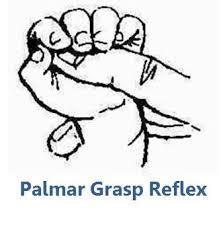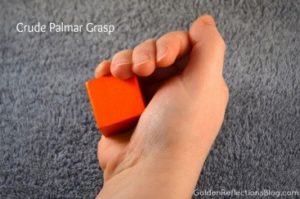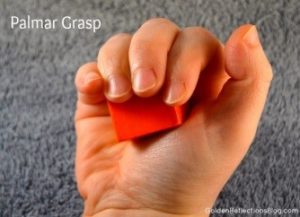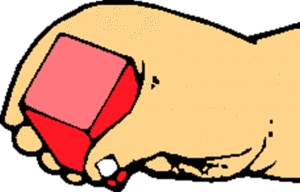Use this list of the typical progression of grasping patterns that develop in the first year to give your child the most appropriate toys and activities for each stage. There are several motivating ways to help your baby develop the varying grasp patterns which will eventually lead to a variety of fine motor skills as they grow. Remember, every child develops at a different rate, but if you notice your child having difficulty progressing through the development of grasp patterns below, an OT may be able to help your child develop and refine these skills to use with functional, day-to-day activities.
Palmar Reflex – we all know this one! When a baby immediately wraps all fingers around your finger or an object placed in his/her palm. This reflex will integrate (go away) around 4 months of age. At this time, your child should begin to demonstrate a voluntary grasp to pick up different sized objects.
Palmar Grasp (typically developed by 4-6 months) – this grasp progresses from your child using his “pinky finger” side of the hand only to pick up objects to using the central portion of the palm to pick up objects from a flat surface. This grasp does not involve use of the thumb.
Radial Palmar Grasp (typically developed by 6-7 months) – at this age, your child should begin to use his/her thumb while picking up objects from a surface. When first adding the help of the thumb to grasp objects, there will be no open space between the object your child is grasping and his/her palm or “web space”.
*When your child is able to voluntary pick up objects using his/her thumb, continue to encourage this! If you notice your child holding a round object and not utilizing his/her thumb, gently place the thumb on the opposing side of the object to encourage this pattern. Strengthening the thumb is vital for upcoming fine motor skills your child will be taught – i.e. pulling on socks/shorts, coloring, cutting, manipulating fasteners, carrying heavier objects (cups of liquid), etc.
Radial Digital Grasp (typically developed 8-9 months) – This is the first grasp where more precise finger movements are required and utilized. Your child will begin to pick up objects with fingertips, rather than whole hand, which leads into the very important, pincer grasp (see below).
*Even though your child may not be able to complete puzzles or successfully stack the blocks or pegs on top of each other at this age, picking up the large knobbed pieces and banging them together or removing the pegs/blocks from a “tower” you build, will strengthen the fingers and thumb for this grasp pattern. You can also prompt your child simply to remove the puzzle pieces and you can demonstrate placing them back in the puzzle.
Immature Pincer Grasp (typically developed by 9 months) – Child will begin to pick up small objects with thumb and index finger only. Initially, your child will only be able to use this grasp with his/her arm supported on the table/surface and will use the side of their index finger and a straight thumb to pick up objects.
Mature Pincer Grasp (typically developed by 12 months) – When the mature pincer grasp is developed, you will notice your child picking up small objects with the tips of thumb and index finger, while holding forearm off of surface.
*Picking up objects from bowls or containers (rather than flat surface) promotes use of fingertips rather than whole hand. Having your child also practice dropping or releasing small objects into different containers is a great way to continue to develop and refine fine motor skills!
**Always be careful when your young child is picking up and playing with small objects. Be sure to pick up small objects when activities are done so as to prevent choking accidents.
Index Finger Isolation (typically developed by 12 months) – Extending only the “pointer” finger to point to pictures, push buttons, express wants/needs. Isolating each of the fingers will be an important skill for your growing child to continue to develop fine motor skills for daily activities.
This blog post was written by Shea Amrhein, Occupational Therapist.









